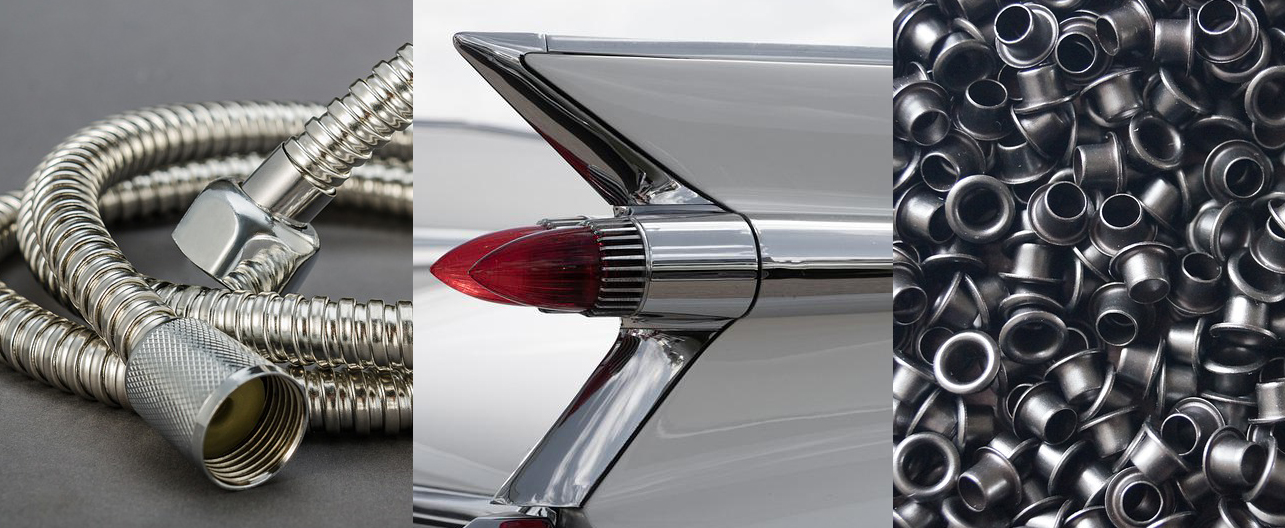Chrome

|
Chrome is short for chromium (Cr), which is a hard grey metal that can be polished to a high sheen. It has a high melting point, and originates from Chromite, which is the only ore in which chromium is found.
In 2020 South Africa was by far the highest global exporter of chromium ore or chromite, followed by Turkey, Pakistan, Kazakhstan and Albania. It is estimated that 99 percent of the world's chromite is found in southern Africa and Zimbabwe, enough to supply the current demand for hundreds of years. Podiform deposits of chromium ore are open-pit mined whilst stratiform deposits and mined underground.
Chromium can be released into the environment by the burning of natural gas, oil, or coal as well as dust pollution from mining and smelting. It does not usually remain in the atmosphere, but is deposited into soil and water where it can change from one form to another and cause damage to marine life. Chrome can be recycled but not easily and chrome plating of aluminium complicates the recycling process for aluminium, though stainless steel scrap metal is generally recycled.
It is an important and indispensable industrial metal because it is hard as well as resistant to corrosion. It is used in the production of stainless and heat resistant (SHR) steels, where often about 18% is chromium, in nonferrous alloys as well as in the creation pigments and chemicals that are used to process leather.
In general its most commonly recognisable use is in kitchen appliances, food processing equipment, medical and dental tools as well as vehicle fittings such as trims and hubcaps. Chromium in super-alloys (high-performance alloys) are stable at high stress-temperatures, as is Chromite which is used in blast furnaces and brick moulds because it retains strength at high temperature.
Chromium is also important for health. Organ meats, mushrooms, wheat germ, and broccoli are good dietary sources of chromium. Insufficient chromium in the body can result in glucose intolerance.
[edit] Related articles on Designing Buildings
- Cast iron.
- Concrete-steel composite structures.
- Constructing steel buildings.
- Corrosion.
- Decorative metal ceilings.
- Failure of metals.
- Galvanised steel.
- Guidance for construction quality management professionals: Structural Steelwork.
- Metal.
- Mesh mould metal.
- Stainless steel.
- Stainless steel vs. galvanised steel.
- Steel.
- Structural steelwork.
- Sustainable materials.
- Types of steel.
- Weathering steel.
- Zinc
Featured articles and news
Latest Build UK Building Safety Regime explainer published
Key elements in one short, now updated document.
UKGBC launch the UK Climate Resilience Roadmap
First guidance of its kind on direct climate impacts for the built environment and how it can adapt.
CLC Health, Safety and Wellbeing Strategy 2025
Launched by the Minister for Industry to look at fatalities on site, improving mental health and other issues.
One of the most impressive Victorian architects. Book review.
Common Assessment Standard now with building safety
New CAS update now includes mandatory building safety questions.
RTPI leader to become new CIOB Chief Executive Officer
Dr Victoria Hills MRTPI, FICE to take over after Caroline Gumble’s departure.
Social and affordable housing, a long term plan for delivery
The “Delivering a Decade of Renewal for Social and Affordable Housing” strategy sets out future path.
A change to adoptive architecture
Effects of global weather warming on architectural detailing, material choice and human interaction.
The proposed publicly owned and backed subsidiary of Homes England, to facilitate new homes.
How big is the problem and what can we do to mitigate the effects?
Overheating guidance and tools for building designers
A number of cool guides to help with the heat.
The UK's Modern Industrial Strategy: A 10 year plan
Previous consultation criticism, current key elements and general support with some persisting reservations.
Building Safety Regulator reforms
New roles, new staff and a new fast track service pave the way for a single construction regulator.
Architectural Technologist CPDs and Communications
CIAT CPD… and how you can do it!
Cooling centres and cool spaces
Managing extreme heat in cities by directing the public to places for heat stress relief and water sources.
Winter gardens: A brief history and warm variations
Extending the season with glass in different forms and terms.
Restoring Great Yarmouth's Winter Gardens
Transforming one of the least sustainable constructions imaginable.






















